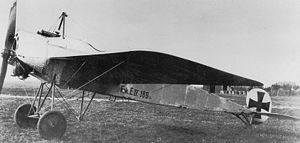Fokker E.IV
| Fokker E.IV | |
|---|---|
 |
|
| Role | Fighter |
| Manufacturer | Fokker-Flugzeugwerke |
| Designer | Anthony Fokker |
| First flight | September 1915 |
| Introduction | October 1915 |
| Primary user | Luftstreitkräfte |
| Produced | 1915-1916 |
| Number built | 49 |
| Variants | E.I - E.II - E.III |
The Fokker E.IV was the final variant of the Eindecker fighter aircraft that was operated by Germany during World War I.
Given the Fokker designation of M.15, the E.IV was essentially a lengthened Fokker E.III powered by the 119 kW (160 hp) Oberursel U.III two-row, 14-cylinder rotary engine, a copy of the Gnome Double Lambda. The more powerful engine was intended to enable the Eindecker to carry two or three 7.92 mm (.312 in) machine guns, thereby increasing its firepower and providing redundancy if one gun jammed - a common occurrence at the time. However, the E.IV was a troubled design that never achieved the success of its predecessor and was soon out-classed by French and British fighters.
The prototype E.IV was accepted for testing by the German Inspektion der Fliegertruppen in September 1915. It was fitted with three forward-firing 7.92 mm (.312 in) lMG 08 "Spandau" machine guns, mounted to fire upwards at 15°. Anthony Fokker demonstrated the E.IV at Essen but the complicated triple-synchronization gear failed and the propeller was damaged. The removal of the left-side gun is believed to have been pioneered on Oswald Boelcke's E.IV, believed to have borne IdFlieg serial 123/15, with a simpler double-synchronisation system used on the retained center-line and right side MG 08 Spandau guns. The fitment of dual MG 08 "Spandau" forward-firing, synchronized machine guns became the standard armament for production E.IVs, and indeed for all subsequent German D-type biplane fighters. The angling of the guns was also abandoned.
...
Wikipedia
